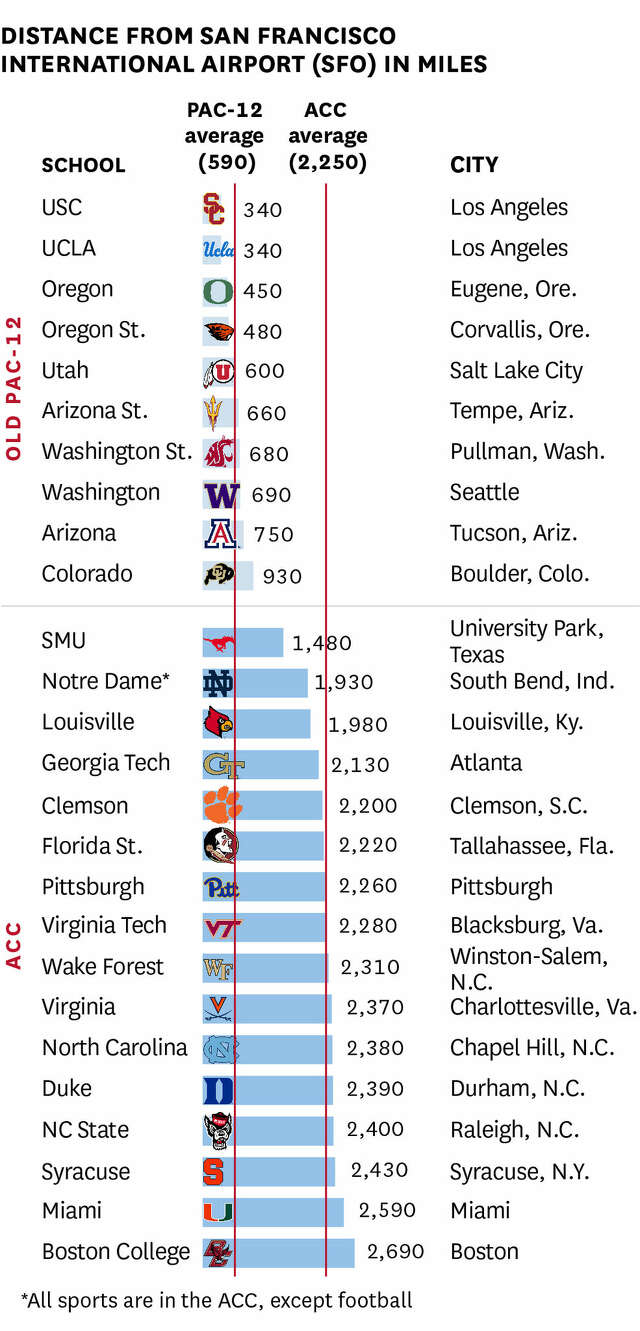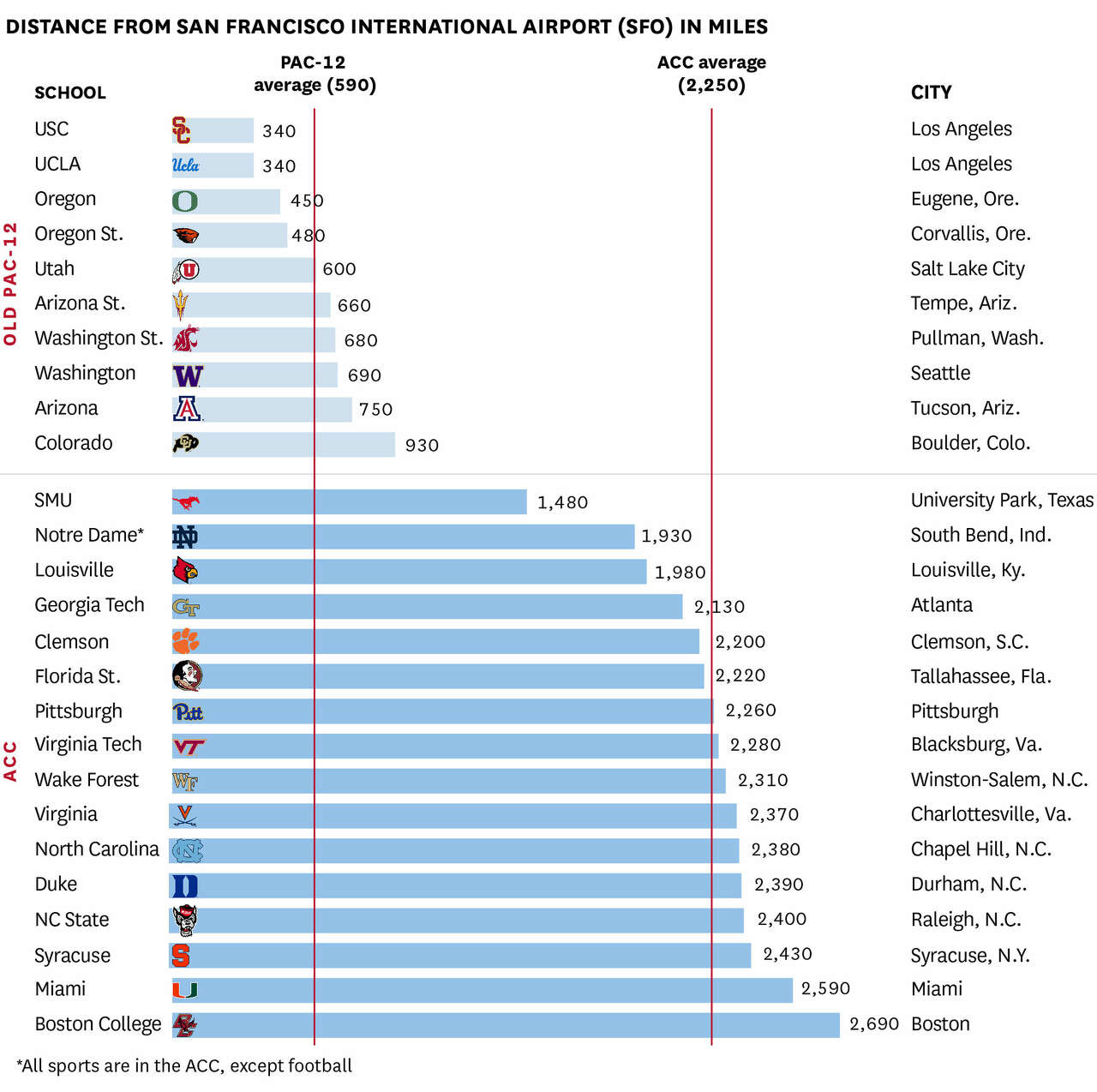Midway through a Zoom news conference Friday morning about joining the Atlantic Coast Conference, UC Berkeley Chancellor Carol Christ fielded the question on many people’s minds: Could the financial concessions the Bears made to remain at the Power 5 level force them to cut sports?
“There is no cutting of sports,” Christ said. “At least on my horizon.”
Christ is set to step down in June 2024, just two months before Cal and Stanford enter the ACC. Her answer Friday seemed to leave open the possibility that the Bears could eliminate some athletic programs once they endure the financial fallout of ACC membership.
After the Aug. 4 announcement of the impending departure of five schools from the Pacific-12 Conference meant the league was on the brink of collapse, Cal and Stanford scrambled for a new conference. With time running low, and other Power 5 leagues expressing little interest, the schools made a significant sacrifice to land ACC invites: They would only receive a 30% share of TV revenue during their first seven years in the league.

UC Berkeley Chancellor Carol Christ poses for a portrait in her office at California Hall on the Cal campus in 2017.
Michael Short/Special to The ChronicleThis was a particularly notable concession for Cal, which has the largest athletic-department debt among U.S. public universities. With travel expenses about to skyrocket in a league that spans the Eastern seaboard, and all current ACC members benefiting financially from expansion, Cal — and, to a lesser extent, Stanford — face a critical next 11 months.
Both schools focused the past four weeks on finding someplace, anyplace, that would let them remain at college sports’ highest level. With that much now assured, Cal and Stanford must decide how to maximize student-athletes’ experience while competing in a conference with “Atlantic Coast” in its name.
Stanford, Cal to travel further afield
The Cardinal and Golden Bears can expect longer flights in the ACC, assuming they fly out of San Francisco.


Mike Massa and Andrew Park / The Chronicle • Source: Chronicle research
Crisscrossing the country for league games brings numerous complications. On top of having to log many more miles than most of their ACC peers and adjust to different time zones, Cal and Stanford athletes could miss a lot more class — a huge issue given the difficulty of their course loads.
“We have to figure out how to balance the competitiveness of our schedule with the travel and making sure we find that happy medium, which is what we tried to do every year with our schedule,” said Stanford softball coach Jessica Allister, who led her team to a Women’s College World Series appearance last season. “It’s no different. It’s just now maybe a little bit of a different puzzle.”

Stanford coach Jessica Allister looks into the stands during the second inning of an NCAA softball Women's College World Series game against Washington, Sunday, June 4, 2023, in Oklahoma City. (AP Photo/Nate Billings)
Nate Billings/APUCLA and USC, which join the Big Ten next summer, reportedly plan to mitigate travel concerns by spending eight figures annually on improved mental health support, academic tutoring and flight arrangements. Charter planes have long been reserved for a small number of teams, but they could become commonplace even for those schools’ Olympic sports teams.
This is possible because UCLA and USC are about to make between $65 million and $75 million per year in Big Ten media-rights revenue, well more than double what they were receiving in the Pac-12. Cal and Stanford don’t have such a luxury. They each will only earn about $8 million annually in ACC TV money for seven years. Some of the cash they forgo will be used to defray travel costs for the conference’s other members.
In other words, Cal and Stanford could stare down a major competitive disadvantage. Current ACC schools will receive roughly $12 million more per year in media rights revenue than Cal and Stanford, and far more than SMU, which also received an ACC invitation Friday after agreeing to take no media revenue for nine years. Not only will their new ACC rivals have more money for staff salaries and recruiting, but those schools can probably do far more than Cal, Stanford and SMU to ease athletes’ travel burden.
“There are things about the world that we don’t like and maybe aren’t fair, but we can’t change them,” Stanford women’s basketball coach Tara VanDerveer said. “If I had a magic wand, I would have football in their own league. And we would play every other sport, regionally, because we play more than one game a week.”
None of the new ACC schools is worse-positioned than Cal. A poorly financed Memorial Stadium renovation helped plunge the school into a $440 million debt, almost $110 million more than any other public university. Things got so grim for Cal that the university has reportedly started paying off some of the athletic department’s deficit.
According to Cal’s 2022 financial report, the school’s men’s Olympic sports teams lost more than $5 million while its women’s Olympic sports teams lost almost $14 million. This only underscores some people’s concerns that plummeting TV revenue could signal the end of at least several non-revenue teams.
Given their dire finances, Cal probably couldn’t afford to go much lower than that 30% TV share in the ACC. The same can’t be said of Stanford. In addition to boasting a $36.3 billion endowment that can serve as a last-resort cushion, the school ranks second only to Harvard with 74 billionaire alums.
Still, the specter of cuts looms as just three years ago Stanford announced it would eliminate 11 sports, only for them to be reinstated a year later. That stunning reversal underscored how Stanford can choose when it decides to prioritize funds to athletics. A recent gender equity report, which came from the fallout of a Title IX lawsuit, may make it more difficult to cut in the future, though.
Tapping into its robust donor base will be key for Stanford to keep pace in the ACC. SMU, which had been trying to go Power 5 for years, has enough support from deep-pocketed boosters not to fret too much.
That all puts even more pressure on Cal to identify new sources of revenue. The school could receive aid from the UC regents, who could make UCLA annually funnel $2 million and $10 million of its new Big Ten money toward its university-system counterpart.
Eight-figure support from UCLA would go a long way in making Cal sports sustainable financially. But if that number is closer to $2 million than $10 million, Cal would need to rely on its donors.

A student leaves Memorial Stadium at the University of California, Berkeley, on Thursday, Oct. 18, 2012, in Berkeley, Calif.
Noah Berger/Special to The ChronicleCal’s third-party booster group, California Legends Collective, announced Monday that it’s trying to raise $1 million in a 72-hour period for ACC-related expenses. Bears alum and Washington Commanders head coach Ron Rivera and his wife, Stephanie, plan to match the first $500,000 raised.
“For the collective, we wanted to start a drive to usher in the new era of the ACC,” said Stephanie Rivera, a co-founder of the collective with her husband. “A lot of people have this concept that Cal doesn’t support their sports, and we wanted to prove we are behind all our sports, not just football and men’s basketball.”
Money is just one aspect for Cal and Stanford to consider as they transition to a conference without any current members within 2,300 miles of the Bay Area. With teams’ annual mileage about to multiply exponentially, Cal and Stanford must think creatively to make travel as efficient as possible.
ACC Commissioner Jim Phillips anticipates Stanford and Cal basketball teams flying to the East Coast three or four times per season, with their lacrosse, soccer and volleyball programs likely having a similar setup. Sports such as baseball and softball could fill much of their schedule with weekend series that would limit the amount of classes athletes miss.
Most of those teams haven’t chartered flights during the regular season, but that might be necessary for extended trips East. VanDerveer mentioned possibly chartering alongside Cal or the Stanford men’s team, schedules permitting.
Christ went so far as to suggest using Dallas, where SMU is based, as a hub for “multi-team tournaments” for Olympic sports. That would cut down on travel, but it would also mean fewer home events for Cal and Stanford programs such as fencing or women’s gymnastics that already don’t host many contests.
Stanford is on the quarter system, which allows more gaps when students can be out of class. Cal, which has an academic calendar consisting of two semesters, might have more challenges travel-wise.
Cal athletic director Jim Knowlton discussed possibly filling the school’s long winter break with as many away games as possible. As Cal prepares for the ACC’s logistical hurdles, some coaches have consulted with field hockey coach Shellie Onstead, whose team has long had to travel to the East Coast on a regular basis.
Onstead “mentioned to me there’s a lot of time to get the study done on those flights,” Cal women’s basketball coach Charmin Smith said. “We’ll manage it.”
In its university-issued news release, Stanford stated that 22 of its 36 teams will barely be affected travel-wise by the ACC move. Sports such as golf, tennis and gymnastics traditionally play in tournament-style events with several teams at one location, with as few as one home event per season.
Other sports, such as men’s gymnastics or water polo, will stay in the Mountain Pacific Sports Federation because the ACC doesn’t sponsor those sports. Cal said 19 of its teams will see a similar schedule as past years.
Such stats reinforce the narrative that the ACC is good news for Cal and Stanford. That’s true in many ways, but the Bay Area schools will face a slew of obstacles — financial and otherwise — by potentially having to trek to far-flung outposts such as Syracuse, N.Y., and Blacksburg, Va.
How Cal and Stanford teams navigate those challenges remains to be seen. But as Christ’s “on-my-horizon” comment highlighted, a worst-case scenario exists. And it’s not pretty.
“I think the Pac-12 was the greatest conference in college athletics when you factor in all sports,” Smith said. “It’s called the ‘Conference of Champions’ for a reason. It’s sad to think that it will no longer be.
“But change happens all the time, and we always adjust to it.”
Reach Connor Letourneau: cletourneau@sfchronicle.com; Reach Marisa Ingemi: marisa.ingemi@sfchronicle.com; Twitter: @marisa_ingemi
Will Cal, Stanford sports face cuts after big sacrifices to join ACC? - San Francisco Chronicle
Read More

No comments:
Post a Comment